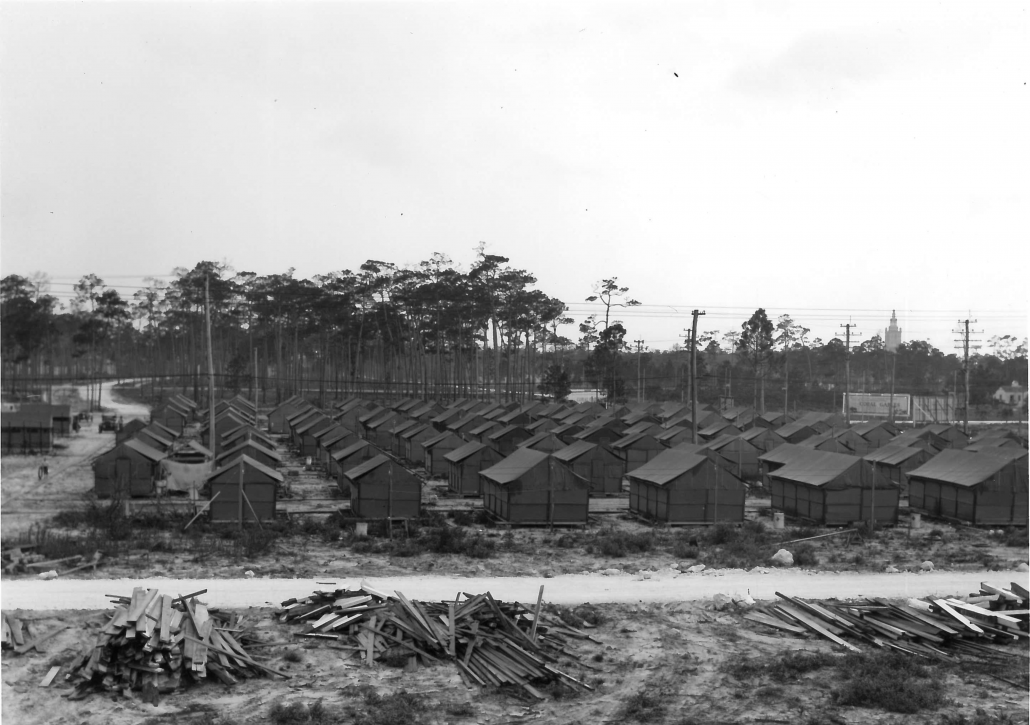Tent City
The City that built the City Beautiful
It was around 1925 that one could find William S. Hammon, a heavy-set, grey haired gentleman, strolling through the city he had recently been declared mayor of. It is likely that Mr. Hammon, a man whose jacket was charitably described as “dusty,” would have never expected to be proclaimed the mayor of anything. In truth, the title was little more than a term of endearment. Additionally, the term “city” only loosely applies to the community he presided over. “Tent City”, as it was called, was comprised of over 600 tents, housed close to 1000 people, and was located in Coral Gables, roughly where Coral Gables Senior High School sits today. The community itself was reminiscent of a slightly upscale refugee camp. Why was this ritzy shanty town located within the boundaries of one of Miami’s most affluent boomtime developments? Why would the City Beautiful and George Merrick deviate from the standards they set for their Mediterranean Revival styled community in favor of wooden shacks and dirt roads? The answers to these questions (and others likely posed) are what this article attempts to address.
In the 1920’s, Miami found itself in the midst of the Great Florida Land Boom. This period of time was punctuated by a huge influx of development; houses, commercial buildings, neighborhoods, and streets were being built at an unparalleled pace. It was during this building boom that neighborhoods and cities such as Miami Shores, Opa Locka, Miami Beach, Miami Springs, and Coral Gables sprung into existence. This surge in construction resulted in an exponentially expanding workforce, which grew to include thousands of construction workers, salesmen, electricians, plumbers, and contractors.
The irony behind this explosive increase of homes, however, was that it resulted in a massive housing shortage for all the laborers and employees associated with the development of these houses and buildings. Affordable housing took a backseat to large single-family homes, leaving common laborers, artisans, administrative workers, and the sales forces with no place to hang their own hat. This problem even entangled George Merrick, the visionary responsible for the creation and development of Coral Gables. Merrick’s attention was drawn to the issue, resulting in the temporary establishment of “Tent City” in October of 1925. In fact, it was Tent City’s future “mayor,” W.S. Hammon, who proposed the idea to Merrick while working for the corporation’s construction branch.
Though purely of temporary construction, the colony was established at a total cost of $85,000 ($1,224,184 today) and was spread over 6 acres of property. Tent City was located approximately where Coral Gables Senior High School is currently situated, on the corner of LeJeune and Bird Road. Like any planned town, it was laid out with streets, individual lots, and a plaza in the center. The “tents” themselves, which were more like cottages, varied in size and had a wooden framework, bolted and reinforced with iron at each joint, had screen doors and windows, and were even waterproof. The interiors were divided into rooms by curtains. They were rented fully furnished and were outfitted with linoleum floors, chairs, beds, dressers, and tables. Each tent was wired for electricity, which with water, was provided free of charge. Electric grills were used for cooking in the interest of fire protection. It is all the more surprising to know that no attempt was made to realize a profit from the enterprise. Rent was nominal and solely served the purpose of maintaining the community.
Those who lived in Tent City took part in regularly scheduled community festivals and events. The “Town Square” was frequently alive with activity. “Mayor” Hammon, whose 12 year old son was considered the maintenance “man,” was very much the community leader; organizing events, activities, and providing supplies and groceries out of his centrally based dry goods store. Tent City housing was initially limited to individuals who worked for the Coral Gables Corporation and their families. Inhabitants were drawn from all departments of the corporation, including the administrative offices, the accounting department, the sales force, and the construction department. While there were plenty of adults, there were also over a hundred children living in Tent City who were enrolled in the Coral Gables school system. It has been reported that, when not in school, the children would play in the “town square” or on the dance platform which had been erected for the recreation of it’s “citizens.”
In April 1926, the completion of the $800,000 San Sebastian Apartments employee hotel resulted in the departure of many of Tent City’s residents. The Corporation promptly altered it’s policies and opened up Tent City to non-company employees. Until it’s liquidation on July 21, 1926, Tent City was available to tourists, prospective home buyers, and Gables residents who were awaiting the completion of their homes. By September of 1926, the development boom had reached it’s peak and was winding down. The structures found within Tent City were auctioned off to the general public in early September.
As for Will S. Hammon, the community’s “dusty” mayor… By 1929 he, his wife Ona, and son Harley, had moved to Columbus, IN, where he returned to working as a retail merchant. Hammon died in Minnesota in 1939 and was buried at Crown Hill Cemetery in Indianapolis, presumably without the dust of Coral Gables on his jacket.
- Written by: Malcolm Lauredo, Feb. 2019
- Edited by: Geisel Dieguez, Jun. 2023






